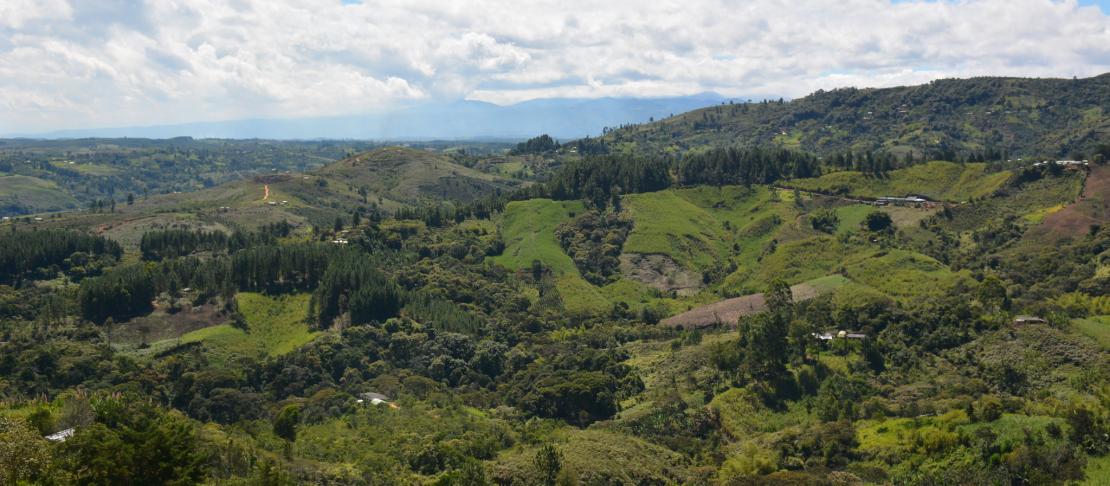Innovation platforms: key spaces for CSA implementation

Research suggests that innovation platforms can facilitate the collective understanding and implementation of climate-smart agriculture (CSA).
Climate change creates different challenges for rural communities. Changes in temperatures and rainfall have already begun to affect the department of Cauca, Colombia, and its rural communities, which have seen how their production systems have been transformed and their food security has been threatened.
Climate-smart agriculture (CSA), a strategy to increase productivity, reduce greenhouse gas emissions and achieve food security, was proposed as a solution for rural communities in northern Cauca, where a Climate-Smart Village (CSV) is located. CSA includes practices such as home gardens, rainwater harvesting, composting, and beans, among others.
In Cauca, researchers from the CGIAR Research Program on Climate Change, Agriculture and Food Security (CCAFS) analyzed how farmers, civil authorities, farmers associations and a local NGO built a network in order to enable participatory implementation of CSA, tailored to an area that struggles with climate change and climate variability. The key to their success? An innovation platform.
An innovation platform is a space to learn, jointly conceive strategies and transform different situations through the improvement of interactions between platform members.
A recent journal article, ‘Can an innovation platform support a local process of climate-smart agriculture implementation?’, highlights how this innovation platform fostered collaboration among multiple actors, enabling the successful implementation of CSA at a local level. The researchers explored the social and technical dynamics within the innovation platform by observing the various interactions among the different actors. They also explored common technical practices and how these changed, and assessed the increased knowledge of farmers.
The study combined several methodologies, ranging from social network analysis and the analysis of tacit and explicit knowledge, to the analysis of the technical-economic effects of the adoption of CSA practices. In this way, the researchers were able to combine a wide range of social and technical indicators in their analysis of the innovation platform dynamics.
It is exactly this combination of different social and technical aspects that allows for the successful implementation of CSA practices. As Nadine Andrieu, lead author of the study, explains, “The innovation is not the technology itself; it’s the socio-technical process that favors the adoption of a new technology in a given community. This paper describes the first steps of this innovation process where farmers are adopting different technologies in their home gardens.”
The adoption of new CSA practices was facilitated by the innovation platform, as it served as a space for learning and strategic collaboration among the different actors. The weekly discussions, trainings, on-field experiments and multi-stakeholder collaboration helped to promote the socio-technical process that Andrieu describes above.
Changes in farmers' lives
The researchers found that farmers’ proactive participation in the platform meetings and the expansion of their knowledge resulted in successful implementation of CSA practices. According to the monitoring results, 90% of the farmers continued to perform the practices prioritized during the first stage of the process. Attendance rates for training sessions also increased significantly from 55% of women and 37% of men in 2015 to 66% of women and 47% of men in 2016. The study concludes that this wide adoption of CSA practices has significantly increased their resilience to the challenges posed by climate change and the resulting extreme events.
Farmers' knowledge of different topics changed in different ways. For some concepts discussed during the training sessions, including “farm planning” and “climate vulnerability”, farmers demonstrated no change in their understanding. For other concepts, such as “extreme events,” farmers demonstrated a significant change, improving from a low to an intermediate level.
Importantly, this innovation platform approach can be replicated in other contexts. The most important element is the facilitation of interactions between people with different origins, backgrounds, and interests, to learn, share ideas, and jointly conceive alternative solutions to their problems. Virtual spaces can provide a basis for these interactions.
"The challenge in such local processes is to broaden dissemination and move towards wider adoption of practices. Creating an enabling environment for change requires a more formal institutionalization of the process with the support of policy makers, donors, development institutions and other stakeholders,” concluded Andrieu.
Acknowledgments
This work was funded by the FONTAGRO program, Agropolis Foundation, and the CGIAR Research Program on Climate Change, Agriculture and Food Security (CCAFS), the CGIAR Research Program on Climate Change, Agriculture and Food Security (CCAFS), which is led by the International Center for Tropical Agriculture (CIAT) and carried out with support from CGIAR Fund Donors and through bilateral funding agreements. For details please visit https://ccafs.cgiar.org/donors.
The views and opinions expressed in this document are those of the authors and do not necessarily reflect official positions of the sponsoring organizations.
We thank the stakeholders who participated in the process, especially the farmers involved in the project, for their time, knowledge, and patience.
Local partners


